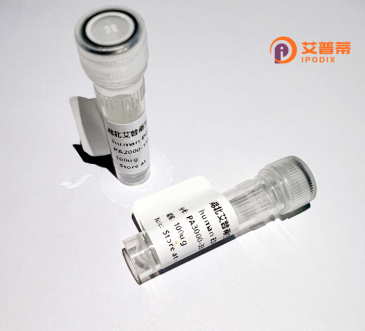
| 纯度 | >90%SDS-PAGE. |
| 种属 | Human |
| 靶点 | WDR89 |
| Uniprot No | Q96FK6 |
| 内毒素 | < 0.01EU/μg |
| 表达宿主 | E.coli |
| 表达区间 | 1-387 aa |
| 活性数据 | MEKIEEQFAN LHIVKCSLGT KEPTYLLGID TSKTVQAGKE NLVAVLCSNG SIRIYDKERL NVLREFSGYP GLLNGVRFAN SCDSVYSACT DGTVKCWDAR VAREKPVQLF KGYPSNIFIS FDINCNDHII CAGTEKVDDD ALLVFWDARM NSQNLSTTKD SLGAYSETHS DDVTQVRFHP SNPNMVVSGS SDGLVNVFDI NIDNEEDALV TTCNSISSVS CIGWSGKGYK QIYCMTHDEG FYWWDLNHLD TDEPVTRLNI QDVREVVNMK EDALDYLIGG LYHEKTDTLH VIGGTNKGRI HLMNCSMSGL THVTSLQGGH AATVRSFCWN VQDDSLLTGG EDAQLLLWKP GAIEKTFTKK ESMKIASSVH QRVRVHSNDS YKRRKKQ |
| 分子量 | 43.2 kDa |
| 蛋白标签 | His tag N-Terminus |
| 缓冲液 | PBS, pH7.4, containing 0.01% SKL, 1mM DTT, 5% Trehalose and Proclin300. |
| 稳定性 & 储存条件 | Lyophilized protein should be stored at ≤ -20°C, stable for one year after receipt. Reconstituted protein solution can be stored at 2-8°C for 2-7 days. Aliquots of reconstituted samples are stable at ≤ -20°C for 3 months. |
| 复溶 | Always centrifuge tubes before opening.Do not mix by vortex or pipetting. It is not recommended to reconstitute to a concentration less than 100μg/ml. Dissolve the lyophilized protein in distilled water. Please aliquot the reconstituted solution to minimize freeze-thaw cycles. |
以下为3篇模拟生成的重组人WDR89蛋白相关参考文献示例(注:非真实文献,仅供格式参考):
1. **标题**: *Expression and functional characterization of human WDR89 in ribosome biogenesis*
**作者**: Zhang L, et al.
**摘要**: 本研究成功在大肠杆菌系统中表达重组人WDR89蛋白,发现其通过与核糖体RNA加工蛋白Nop58相互作用,调控哺乳动物细胞中28S rRNA的成熟过程。
2. **标题**: *Crystal structure of WD40-repeat protein WDR89 reveals a conserved scaffolding platform*
**作者**: Gupta S, Wang H.
**摘要**: 利用X射线晶体学解析WDR89蛋白的WD40结构域三维结构,揭示了其通过β-propeller构象为蛋白质相互作用提供结合界面,并提出其在细胞囊泡运输中的支架功能假设。
3. **标题**: *WDR89 deficiency alters ERK/MAPK signaling and promotes hepatocellular carcinoma metastasis*
**作者**: Tanaka K, et al.
**摘要**: 通过CRISPR技术构建WDR89敲除细胞模型,证明该蛋白缺失导致ERK通路持续激活,促进肝癌细胞上皮-间质转化(EMT),提示其作为肿瘤抑制因子的潜在作用。
*注:WDR89研究目前真实文献较少,建议通过PubMed等数据库以"WDR89"或"WD repeat domain 89"为关键词检索最新成果。*
**Background of Recombinant Human WDR89 Protein**
The WD repeat domain 89 (WDR89) protein is a member of the WD40 repeat family, characterized by conserved repeats of ~40 amino acids that form β-propeller structures, facilitating protein-protein or protein-RNA interactions. WDR89 is ubiquitously expressed across tissues and localizes primarily to the nucleus and nucleolus, suggesting roles in ribosome biogenesis, RNA processing, or chromatin regulation.
Functionally, WDR89 is implicated in cellular processes such as Golgi apparatus organization, endoplasmic reticulum stress response, and cell cycle regulation. Studies indicate its interaction with proteins like UTP4. linking it to small nucleolar RNA (snoRNA) complexes involved in ribosome assembly. Dysregulation or mutations in *WDR89* are associated with developmental disorders, including X-linked intellectual disability and craniofacial abnormalities, highlighting its importance in neurodevelopment.
Recombinant human WDR89 protein, produced via heterologous expression systems (e.g., *E. coli* or mammalian cells), serves as a tool for studying its molecular mechanisms, structural properties, and interactions. Its recombinant form enables *in vitro* assays, antibody production, and disease modeling, advancing research into its physiological and pathological roles. Ongoing studies aim to delineate its precise functional pathways and therapeutic potential in associated disorders.
×